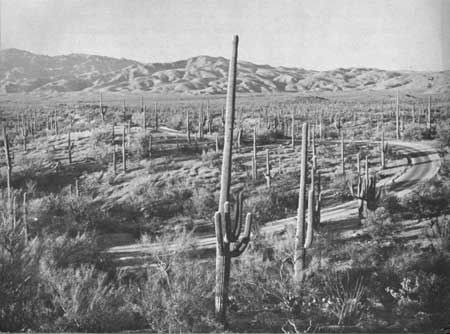|
SAGUARO National Park |
 |
What's In a Name?
In spite of unrelenting drought and heat, cactuses have been particularly successful and have populated the landscape with weird and bizarre shapes, so effectively that Saguaro National Monument has been called "a wilderness of unreality." Largest of the cactuses in the United States, the giant saguaro attains maximum size and density of growth in the "cactus forest," thereby giving the monument its name.
The word "saguaro" is believed to stem from a Spanish corruption of a Papago Indian word for the big cactus. Following Coronado's historic expedition into this region in 1540, European explorers found peaceful Papagos and Opatas living here, hunting animals and utilizing many native plants. Among the most dependable of Papago food sources was the fruit of the giant cactus. So important was this fruit harvest in their economy that they designed this season as the start of a new year. Thus, the native Indians and the rich and varied animal life made use of the desert vegetation, thereby adjusting themselves to a meager existence in this land of much sunshine and little rain. Saguaro National Monument is not merely a rectangle on the map made up of so many square miles of land; rather, you should think of it as a living community of interdependent plants and animals, each one striving, as an individual and as a species, to expand its activities within limitations set by climate, elevation, soil, topography, competition, and enemies.
 The Cactus Forest Loop Drive through typical Lower Sonoran, or Arboreal Desert vegetation. |
Here then is a splendid exhibit of nature in action illustrating the response of the animate and the inanimate to the unchangeable laws of the Creator. Here is an outdoor experience that you may enjoy according to your personal desires as long as you help to retain for others the delicate adjustment of the living desert. This adjustment has been attained through hundreds of centuries of adaptation of plants and animals to an unique and inflexible environment.

|

|
|
|
|
Last Modified: Sat, Nov 4 2006 10:00:00 pm PST |


